Our Septic Tank Size Calculator is a simple and easy to use tool that helps homeowners and contractors determine the appropriate size for a septic tank based on the number of bedrooms, daily water usage, and soil percolation rate.
It’s very important to note that the calculator is only an estimate and actual tank size may vary based on local regulations, soil conditions, and other factors.
To use the calculator, simply follow these steps:
- Input the number of bedrooms in the house in the “Number of Bedrooms” field.
- Input the daily water usage in gallons in the “Daily Water Usage” field.
- Input the soil percolation rate in inches per hour in the “Soil Percolation Rate” field.
- Click the “Calculate” button.
The calculator will then use the information provided to determine the appropriate septic tank size in gallons and will display the result.
It’s always best to consult with a professional plumber or septic contractor for a more accurate assessment.
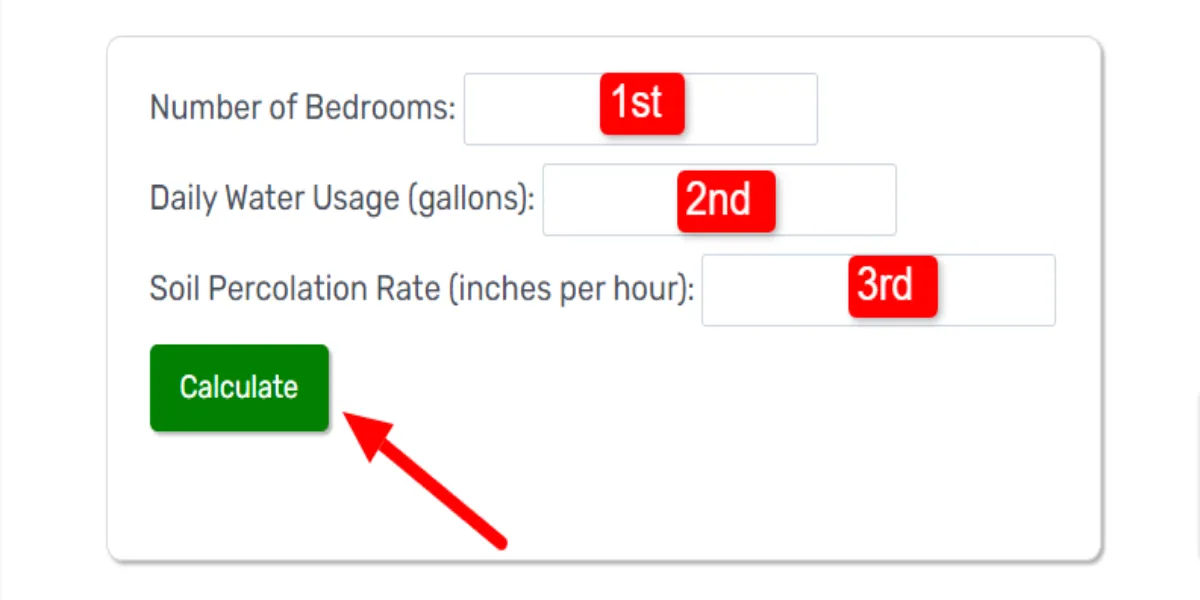
Benefits Of Using Our Septic Tank Size Calculator
Our Septic Tank Size Calculator offers many benefits to homeowners and contractors. Here are just a few:
Convenience:
With our calculator, determining the appropriate size for a septic tank is a quick and easy process.
Simply input the number of bedrooms, daily water usage, and soil percolation rate, and the calculator will provide an estimate of the appropriate tank size.
This eliminates the need for homeowners and contractors to manually calculate the tank size themselves, saving time and effort.
Accurate Estimates:
By using the calculator, homeowners and contractors can get an accurate estimate of the appropriate septic tank size based on the specific information provided.
This can help with budgeting and planning for the project and ensure that the tank size is adequate for the needs of the home or property.
Local Compliance:
Septic tank size is often determined by local regulations and building codes.
By using our calculator, homeowners and contractors can ensure that the tank size they are planning for meets these requirements.
This can help avoid potential delays or complications during the permitting and installation process.
Factors consideration:
The calculator takes into account several factors that can impact septic tank size, including the number of bedrooms, daily water usage, and soil percolation rate.
By considering these factors, the calculator can provide a more accurate estimate of the appropriate tank size.
Mobile friendly:
Our calculator is mobile-friendly, so it can be accessed and used on a variety of devices including smartphones, tablets, and laptops.
This makes it easy to use while on the go and eliminates the need to be tied to a desktop computer.
Easy to use:
Our calculator has a user-friendly interface and is easy to use even for those without any technical knowledge.
With clear instructions and labeled fields, homeowners and contractors can quickly and easily input the necessary information and get an estimate of the appropriate septic tank size.
Professional Looks:
The calculator has a professional and modern look with white background, green button and shadow effect, this can give users a better experience while using the calculator.
Cost Effective:
By using our calculator, homeowners and contractors can avoid the cost of hiring a professional to calculate the appropriate septic tank size.
This can save money and help to keep the project budget on track.
Saving Time:
With our calculator, homeowners and contractors can get an estimate of the appropriate septic tank size in a matter of minutes.
This can save time and help to keep the project on schedule.
Better planning:
With a clear idea of the appropriate septic tank size, homeowners and contractors can make better-informed decisions about the project and plan accordingly.
This can help to ensure that the project is completed on time, within budget, and to the highest quality standards.
How to Calculate the Size of Your Septic Tank
One of the first things to consider is the number of bedrooms in your home. According to the National Sanitation Foundation (NSF), a septic tank should be able to hold a minimum of one gallon of liquid per bedroom in the house.
So, for example, if you have a four-bedroom home, your septic tank should be able to hold at least four gallons of liquid.
Another important factor to consider is the flow rate of your home’s wastewater. This is measured in gallons per day (GPD) and can be calculated by multiplying the number of bedrooms in your home by a flow rate of 150 GPD per bedroom.
So, for a four-bedroom home, the flow rate would be 600 GPD.
It’s also important to take into account any additional sources of water that may be flowing into your septic tanks, such as a washing machine, dishwasher, or pool.
These sources can significantly increase the flow rate, and should be factored into your calculations.
In terms of tank size, it’s generally recommended to have a septic tank that is at least 1000 gallons for a two-bedroom home, 1500 gallons for a three-bedroom home, and 2000 gallons for a four-bedroom home.
These are general guidelines and you should consult with a septic professional to determine the specific size of the tank that will best suit your needs.
To help you visualize the size and flow rate of your septic tank, here is a diagram:
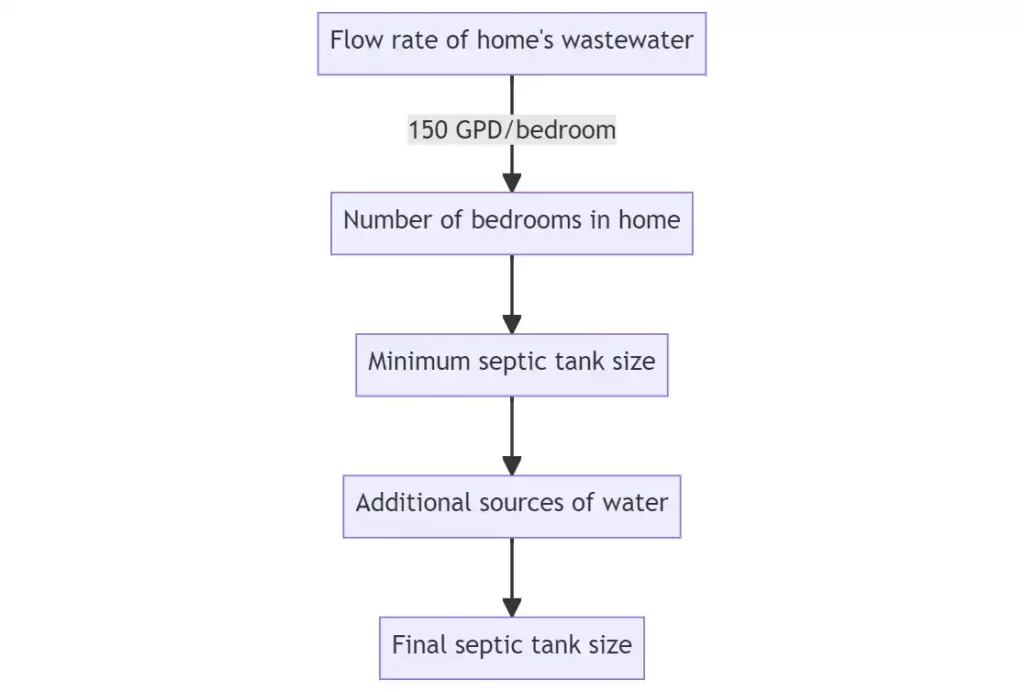
Greetings, if you are looking for more information regarding the size of septic tanks, we recommend you to read our comprehensive guide below. Here, we provide an in-depth explanation of various septic tanks from sizes and shapes to charts.
Septic Tank Size Calculator – Learn The Basic First
Following are some basic information about septic tank
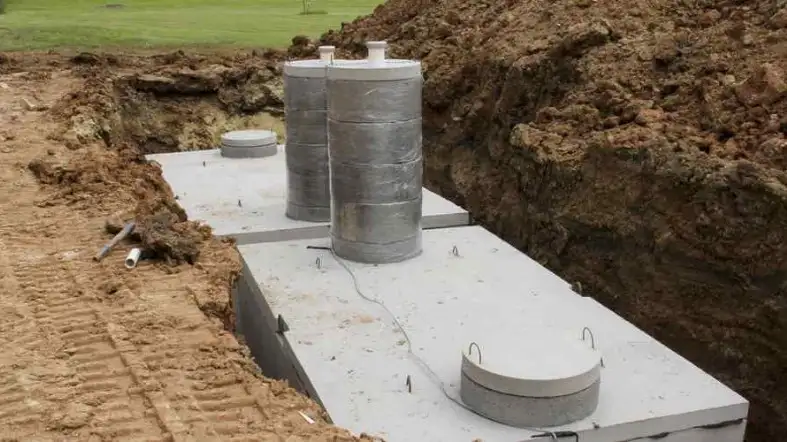
Usage
Septic tanks are mostly used in rural and urban areas where an appropriate sewer system is missing.
Currently, every residential and commercial building has a septic tank to preserve sewage for a little while before transferring it to the sewer line and avoiding clogging.
Typical septic tanks are constructed with brick walls or concrete following a rectangular shape and consist of at least two chambers.
Process
Wondering how septic tanks work? Septic tanks receive effluent like solid or liquid waste from households via an inlet pipe.
It stores the wastewater for at least 18 to 24 hours, which is called the detention period.
During the detention period, anaerobic bacteria’s biological action decomposes the sludge and lets the solid waste resolve as sludge.
After that, the surface water moves to the soak pit via the outlet pipe, and the settled sludge stays in the tank for years.
Don’t know what a soak pit is? It’s a circular-shaped pit dug under the ground made of stone or dry bricks that allows the ground to soak water.
Its top portion is usually made of an RCC slab that needs to be placed not less than 2 meters from the groundwater.
Septic Tank Size Calculation
Septic tank size varies depending on the shape, material, and purposes it will be used for.
Hence, we have listed a septic tank size calculator for various shapes of septic tanks, conventional brick and concrete septic tanks, as well as residential and commercial septic tanks for your convenience.
Let’s start with the most common method of sizing conventional septic tanks, which is rectangular and determined based on water consumption:
Based Per User Consumption For Rectangular Shape
An incorrectly designed septic tank will not only cause your wastewater to back up into the house, force you to clean water frequently, but also increase construction and maintenance costs.
Calculating a septic tank based on a family member is an effective way to get the right size. However, it may hurt if guests stay in the house for a long time.
Following a calculation of a septic tank for a family of five members,
Determine The Water Usage

The amount of water approximately a 5 member’s family uses is:
| Purposes | Amount Of Usage Water |
|---|---|
| Cooking | 8 Liters |
| Washing cloths and Utensils | 35 Liters |
| Bathing and Toilet | 425 liters ( per person 85 Liters) |
| Cleaning House | 15 Liters |
| Other purposes | 10 Litres |
Total usage of water = 493 Litres/Day
Add Detention Period
Though we mentioned the detention period is typically 18 to 24 hours, let’s consider 3 days to avoid hassles due to long-term unwanted visitors.
So, the sum volume of water that will be retained in the tank is = 493×3 = 1479 liters.
Turn the amount into a round figure and consider 2000 liters to avoid frequent cleaning. The recommended minimum septic tank depth is not less than 1.8m.
Measure The Amount Of Sludge
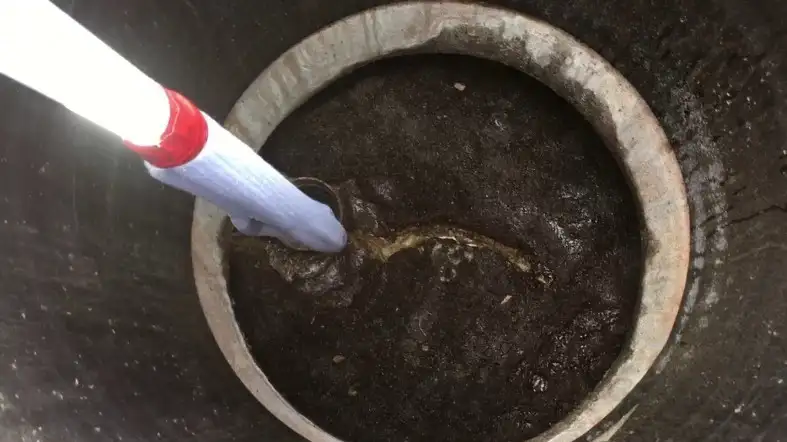
Typically, 30 liters of sludge settle down per person every year. Consider the period for sludge removal once every 2 years.
So total sludge = 30 litres x 5 people x 2 years = 300 litres.
Measure Overall Tank Capacity
Now the total septic tank capacity should be = 2000+300 = 2300 liters.
Dimension Of The Septic Tank
In general, 1 cume area requires holding 1000 liters.
It means the total area require = 2300/1000 = 2.3 cum
Dividing with the depth, the area requires 2.3/1.8 = 1.2 Sqm
To determine the septic tank dimension, you should choose either a 4:1 or 2:1 length or breath ratio.
Consider the 4:1 ratio,
So the breadth is = 4BxB = 1.2 Sqm
B=0.54m
But the minimum requirement for the breadth is 750mm.
Now, the length requires L = 4×0.75 = 3m.
That means the dimension of the septic tank for a family with five members is
B = 0.75m
L = 3m
Depth = 1.8+0.3 = 2.1m (considering minimum 300mm free board)
Overall Tank capacity = 3 x 2.1 x 0.75 = 4.725 cum
So it will hold water =4.725x 1000 = 4725 Liters
Septic Tank Capacity In Gallon Calculation Using The Dimension
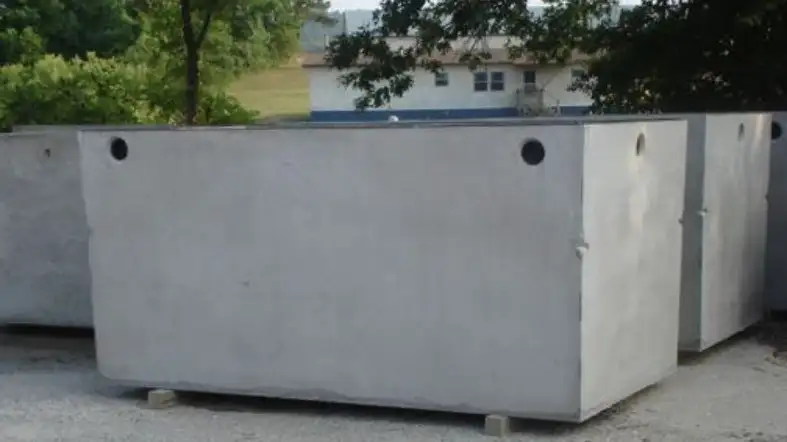
Though the rectangular shape is commonly used for septic, it’s not the only option available.
Alternatively, you can install a round septic tank if you prefer.
Whatever the shape, there are some tricks to determining septic tank capacity using the dimensions discovered using the above-mentioned method:
Rectangular Septic Tank
For Feet= Length x Width x Depth x 7.5 = gallons
Or,
Length x Width x Depth / .1337 = gallons
Round Septic Tank
- For feet= 3.14 x radius squared x depth x 7.5 = gallons capacity
- For inches = Length x width / 231 = gallons per inch
Some constants to sizing septic tank:
- One gallon = 0.1337 cubic feet or 231 cubic inches
- 1 cubic foot = 7.48 gallons.
Some recommended septic tank sizes based on capacity on gallon or litter
| SL | Septic Tank Size (gallon) | Septic Tank Size (liter) | Dimension |
|---|---|---|---|
| 1 | 600 gal | 2271.25 liter | 6.5’L x 56’W x 60’H |
| 2 | 800 gal | 3028 liter | 8’L x 67’W x 57’H |
| 3 | 1000 gal | 3785 liter | 8’L x 6.5’W x 5.08’H-heady duty10’L x 67’W x 57’H- low profile |
| 4 | 1200 gal | 4542 liter | 9.25’L x 6.5’W x 5.08’H |
| 5 | 1600 gal | 6056 liter | 12.08’L x 6.5’W x 5.08’H |
| 6 | 2000 gal | 7570 liter | 13.5’L x 6.5’W x 5.33’H |
| 7 | 2600 gal | 9842 liter | 12.25’L x 7.5’W x 6.08’H |
| 8 | 3000 gal | 11356 liter | 13.75’ L x 7. 67‘W x 6.41’H |
| 9 | 5000 gal | 18928 liter | 17’ L x 8’ W x7.75’ H |
Concrete Septic Tank Sizes

The popularity of concrete septic tanks is growing dramatically due to their durability, strength, and weight.
After being constructed properly, a concrete septic tank reduces the risk of cracking, breaking, and floating.
And proper maintenance can keep a concrete septic tank functioning for up to 40 years.
However, it depends on the quality of the construction, as it needs to use tip-class concrete, water seal, and structural steel.
Aside from that, a concrete septic tank can crack under cold conditions and tends to leak more compared to a plastic or fiberglass septic tank.
In addition, concrete septic tanks require professional installation because of their weight and size.
Since this type of septic tank is made of the heaviest material, it requires large and heavy tools to install.
Most of the septic tanks are also pre-cast, hence their dimensions vary.
Some concrete tanks also come in heavy duty form and are constructed with reinforced tops.
These can withstand a load of farm equipment, automobiles, or various heavy machinery, make them preferable for busy and challenging areas.
Calculating Concrete Septic Tank
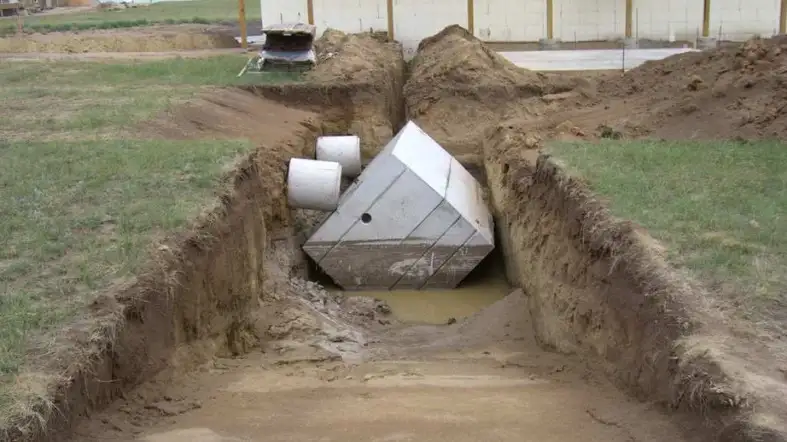
The process of determining the size of the required septic tank is the same as the method mentioned above.
Apart from that, you can also follow this method for sizing a concrete septic tank:
Suppose your proposed area for a septic tank is 4.5 ft. W x 8.0 ft. L x 6 ft. H.
The volume of the area is 4.5 x 8 x 6 = 216 cubic feet.
As you already know, 1 cubic foot can hold 7.481 gallons, or 7.5 gallons per cubic foot.
The tank capacity should be 216 x 7.5 = 1620 gallons.
But remember, if the septic tank contractor gives the concrete septic tanks external dimension instead of its internal dimension, then the given volume will be higher than the actual capacity.
The outer dimension is crucial, particularly for installing a septic tank in a tight space.
Some Standard-Size Concrete Septic Tanks Are Based On Family Size
| Family size | Septic tank capacity | dimension | Weight of the septic tank | Excavation Depth |
|---|---|---|---|---|
| 0-3 bedroom homes | 1000 gallon | 5’ 1” X 8’ 2” X 5’ 8” | almost 9,000 lbs | Around 9 1/2 feet |
| 3-4 bedrooms | 1250 gallon | 5’ 9” x 8’ 6” x 5’ 8” | 11,000 lbs | Around 11 1/2 feet |
| 5+ bedrooms | 1500 gallon | 6’ x 10’ 9” x 5’ 5” | 12,000 lbs | Around 12 feet |
Concrete Septic Tank Dimension Chart Based On Capacity

| Rectangular Concrete Septic Tank | Dimension ( in inches) |
|---|---|
| 600 gallons | 78 x 56 x 60 |
| 800 gallons | 96 x 67 x 57 |
| 1000 gallon heavy duty | 96 x 78 x 61 |
| 1000 gallon low profile | 120 x 67 x 57 |
| 1000 /600 gallon | 145 x 68 x 61 |
| 1200 gallon | 111 x 78 x 61 |
| 1250/750 gallon | 162 x 78 x 64 |
| 1600 gallon | 145 x 78 x 61 |
| 1600/1400 gallon | 174 x 90 x 73 |
| 2000 gallon | 162 x 78 x 64 |
| 2600 gallon | 147 x 90 x 73 |
| 3000 gallon | 165 x 92 x 76 |
| 5000 gallon | 204 x 96 x 93 |
Commercial Septic Tank Sizing Chart

Following are some essential steps to measure the required commercial septic tank:
Calculate the flow per day
The flow of water varied depending on the activities per person per day.
In this case, flows and loads 4 will give you a basic idea to consider a standard amount of water flow based on your application.
For example, if you are planning to install a commercial septic tank for your office with a canteen, note down the recommended amount of flow per person for each activity based on the business.
On average, each guest in the hotel requires 80 litters water per day while on two days staff requires 90 liters.
Calculate The Total Liters Per Activity
This’ll let you determine the total liters of water required per day. Considering the hotel example, the calculation will be:
- For 20 guests= 80 x 20= 1600litres
- For 2 day stuff= 2 x 90= 180litres
So the total maximum water flow require per day= is 1600+180= 1780litres
Calculate septic tank size
Add extra 2000litres to the max flow per day to get the required capacity septic tank
The calculation is= 1780+2000= 3780litres
Since the 3780litres tank is ant available consider the closest round figure which is 3800 or 4000.
But don’t go for the too larger septic tank as it’ll cause septicity and produce odor.
Standard Size Commercial Septic Tank for Small Office
With Canteen
| Number of staff | Max flow per day ( in Litres) | Minimum size septic tank requires ( in Litres) |
|---|---|---|
| 1 | 90 | 2090 |
| 2 | 180 | 2180 |
| 3 | 270 | 2270 |
| 4 | 360 | 2360 |
| 5 | 450 | 2450 |
| 10 | 900 | 2900 |
| 20 | 1800 | 3800 |
| 30 | 2700 | 4700 |
Without Canteen
| Number of staff | Max flow per day ( in Litres) | Minimum size septic tank requires ( in Litres) |
|---|---|---|
| 1 | 50 | 2050 |
| 2 | 100 | 2100 |
| 3 | 150 | 2150 |
| 4 | 200 | 2200 |
| 5 | 250 | 2250 |
| 10 | 500 | 2500 |
| 20 | 1000 | 3000 |
| 30 | 1500 | 3500 |
The Standard Size Of A Septic Tank For Residential

Wondering how big a septic tank should be for residential use?
The following steps will let you figure out the answer regardless of the size of the residential area and the number of residents:
Calculate The Number Of Residents In The Building
In this case, British water flows and loads rules aid you figure out the information without visiting every unit.
According to the British water flows and loads rules, 1-3 bedrooms unit is considered as 5 people family.
This way you can figure out the total number of residents in the building by simply checking the building plan.
Following is a chart of various numbers of bedrooms with classed people:
| Number of Bedrooms | Number of people |
|---|---|
| 1-3 | 5 |
| 4 | 6 |
| 5 | 7 |
| 6 | 8 |
| 7 | 9 |
| 8 | 10 |
Calculate the max flow per day
Once get the total number of people in the building, multiply it by 150 to find out the max water flow require per day.
150 liters is the average volume of water produced per person in a typical household according to the British water standard.
Following is the upgrade of the previous table after adding the max flow require per day
| Number of Bedrooms | Number of people | Maximum Flow Per Day |
|---|---|---|
| 1-3 | 5 | 750 |
| 4 | 6 | 900 |
| 5 | 7 | 1050 |
| 6 | 8 | 1200 |
| 7 | 9 | 1350 |
| 8 | 10 | 1500 |
Sizing Residential Septic Tank

After determining the maximum flow, add extra 2000 liters to make sure the septic tank is larger enough to allow solid to split and drop down to the tank’s bottom.
Otherwise, the too-small septic tank will cause disturbance in the water and let the sludge build up quickly.
Let’s complete the table
| Number of Bedrooms | Number of people | Maximum Flow Per Day ( in liter) | Minimum size septic tank requires ( in liter) |
|---|---|---|---|
| 1-3 | 5 | 750 | 2750 |
| 4 | 6 | 900 | 2900 |
| 5 | 7 | 1050 | 3050 |
| 6 | 8 | 1200 | 3200 |
| 7 | 9 | 1350 | 3350 |
| 8 | 10 | 1500 | 3500 |
Some Handy Tips To Maintain A Septic Tank Properly
- You should construct the right septic tank at the correct location to avoid wasting money and keep the environment fresh and healthy.
- Ensure proper water usage to avoid filling the tank more quickly and save on utility bills.
- Inspect and remove sludge regularly to retain the functionality of the septic tank.
- Design and construct the septic tank to avoid polluting the groundwater.
- If the septic tank is clogged, fix the problem to avoid polluting the environment.
- The manhole should offer easier access to the tank.
- Don’t flush sanitary items, garbage, or other solid particles into the tank to avoid clogging.
- Don’t attach another source of water to the septic tank
- Don’t run wastewater in the ground to keep the environment healthy.
FAQ About Septic Tank Size
What Is The Standard Size Of The Septic Tank?
A 5’ L x 2.5’ W x 3.3’ D septic tank is considered the standard-size septic tank. It can hold around 1000 liters of liquid waste and is suitable for installing a house with 5 members.
Is A 500-Gallon Septic Tank Big Enough?
The right size septic tank required is dependent on plenty of factors, including the number of family members and the square footage area of the house. While most residential septic tanks come in 750 gallon to 1,250 gallon capacities, 500 gallons can be smaller for installing a family with 3 members.
How Long A 1000-Gallon Septic Tank Will Take To Fill With Water?
A 1,000-gallon septic tank may fill with water within 1.5 years. However, if the adults work outside for most of the time and the children go to school, you may need to pump the tank every 2 to 3 years.
Final words
Our Septic Tank Size Calculator is a valuable tool for homeowners and contractors.
It provides accurate estimates of the appropriate septic tank size, helps to ensure compliance with local regulations, and saves time and money.
With its user-friendly interface, mobile-friendly design, professional looks and easy to use, the calculator makes it easy for anyone to determine the appropriate septic tank size for their project.
